Khan toke: a versatile container of the Northern Thai Tradition
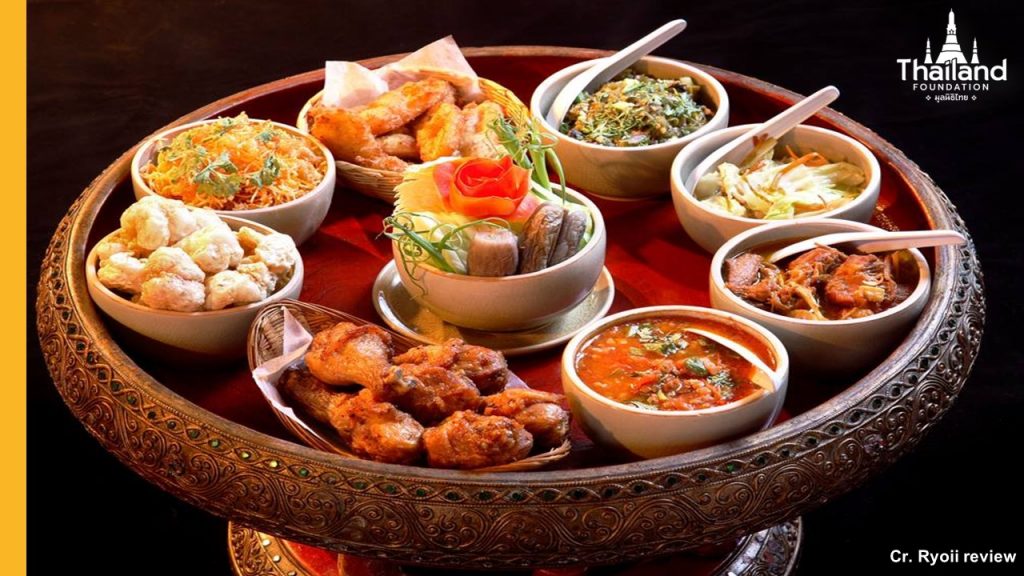
Khan toke
(Photo credit: Ryoii review)
While visiting Northern Thailand, one of the must-do experiences for travelers is to enjoy a local meal set served on a circular raised tray while watching traditional performances. This activity is often referred as “khan toke dinner.” Because of this trend, many visitors understand khan toke as a type of meal set. Yet, in its truest sense, the term “khan toke” refers to a type of a food container that is a part of Northern Thai culture and cuisine. Today, we will take you on a journey of the noble household item that is “khan toke”.
What is khan toke?
Toke (โตก), satoke (สะโตก) or khan toke (ขันโตก) is a round tray with a pedestal base, which is used by Northern Thai people, Laotians, and people from Northeastern Thailand (Isan). It is made of either wood or woven rattan, adorned with carvings and finished with lacquer. The tradition of using khan toke has been observed by the Northern Thai people for a very long time, becoming an important component in the Northern Thai way of life. The object also expresses artistic finesse of the Northern Thai craftsmen.
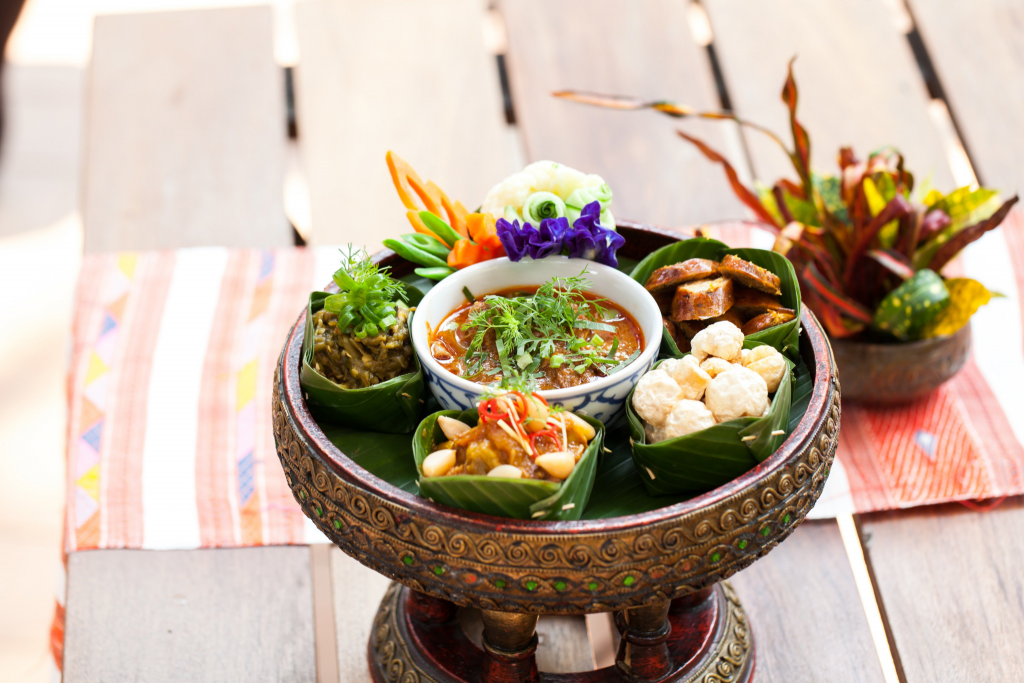
Khan toke
(Photo credit: Amazing Thailand)
What is the khan toke used for?
Being a ubiquitous household item, khan toke serves many purposes. In Northern Thailand, these purposes include:
- Khan toke as a dining table: Khan toke is typically used as a dining table for in-house family meals and for welcoming important guests. A variety of traditional Northern Thai dishes are served on the khan toke in bowls or plates. Family members will gather around the khan toke, sitting on the floor with mats or cushions, to share a meal together. When it comes to receiving guests, inviting them to have a meal served on khan toke is considered a symbolic gesture of welcome on the host’s parts.
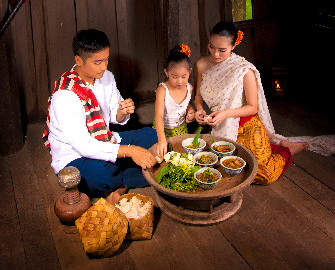
In-house family dining with khan toke
(Photo credit: Chiangmai University Library)
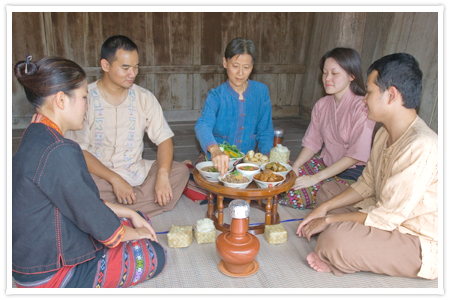
In-house family dining with khan toke
(Photo credit: Michelin Guide)
Some popular dishes served on the khan toke include gaaeng hung lay (แกงฮังเล-Northern style curry), nam phrik ong (น้ำพริกอ่อง-pork and tomato Chili dips), nam phrik noom (น้ำพริกหนุ่ม -green chilli dips) with pork cracklings, sai ua (ไส้อั่ว-Northern Thai spicy sausage), and boiled vegetables. All these items are served with glutinous rice, the staple food of the Northern Thailand.
The meal served on khan toke is often designed to create a balanced combination of flavors, textures, and ingredients. Certain dishes, for example, may emphasize spiciness while other dishes may emphasize sourness. A good example is the dish nam phrik noom, whose flavor emphasizes spiciness and whose texture is soft and squishy. This dip is often eaten with sai ua, pork cracklings, and glutinous rice. The pork cracklings provide a crunchy texture that contrasts with the dip’s smooth texture, while the starchiness of glutinous rice helps balance off the dip’s spiciness. The sai ua, on the other hand, compliments the whole meal with a hearty source of protein. After finishing the main dishes, Northern Thai desserts, such as rice crackers and khanom jok (ขนมจ๊อก – stuffed dough pyramid) may be served to conclude the meal.
The balanced combination of flavors and textures is designed to create a pleasurable experience for those enjoying the meal. For family meals, the diversity of dishes can appeal to the preferences of different family members. Boiled vegetables, for example, are suitable for elders. Meaty, robust dishes, on the other hand, are suitable for adults and teens. In the context of receiving guests, the host’s care and effort in preparing an enjoyable meal can help guests to truly feel welcomed.
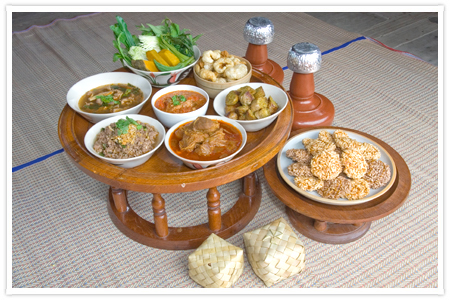
Northern Thai dishes being served on khan toke
(Photo credit: Chiangmai University Library)
Khan toke’s presentation in a meal set has garnered international attention. When Chariya Khattiyot, a contestant from Northern Thailand, won the title of MasterChef UK 2023. She selected “khan toke” as her main dish in the competition as she grew up in Northern Thailand. Her “khan toke ” consists of wagyu sirloin steak in hung lay curry sauce, minced lamb in a spicy tomato, and shrimp paste.
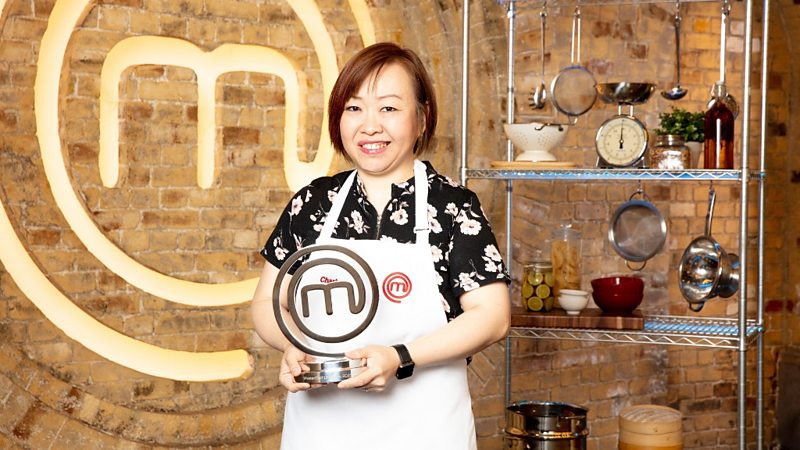
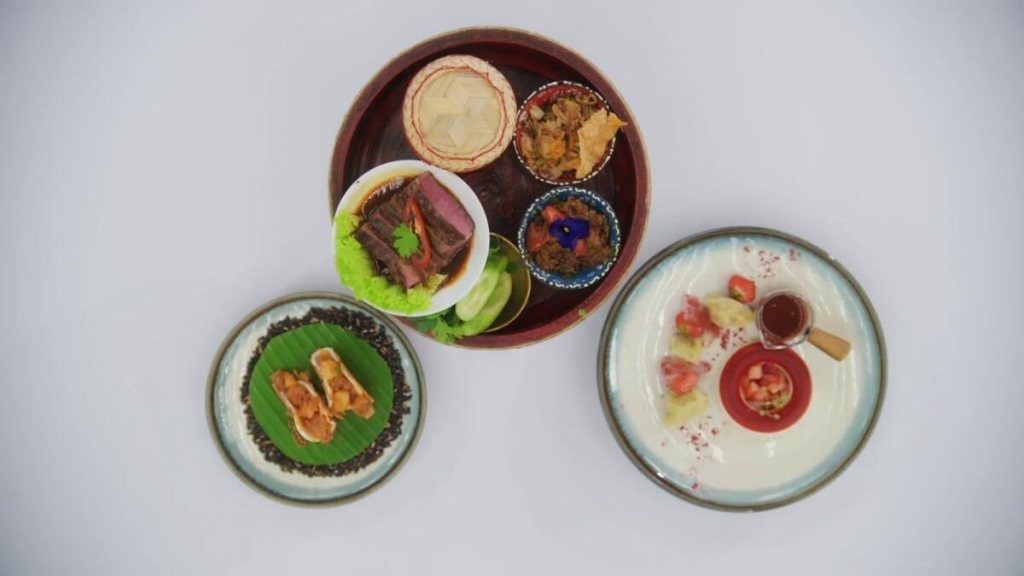
Chariya Khattiyot and her dish of “khan toke” in MasterChef UK 2023
(Photo credit: @UKinThailand Twitter)
- Khan toke as a traditional food container: Apart from serving as a dining table, khan toke is traditionally featured as a food container. It is used to hold items, such as fruits, to keep them organized and easily accessible.
- Khan toke as an offering container: Khan toke is also used to hold offerings, such as flowers, incense sticks and candles, for sacred rituals and religious ceremonies. For example, khan toke is used for presenting offerings during Wai Khru ceremonies in order to pay respect and homage to teachers or deities of various fields of study. Moreover, khan toke can also serve as a container used to present offerings to monks during merit-making ceremonies. The type of khan toke featured here is typically adorned with intricate designs.
When the khan toke is filled with offerings of flowers, incense sticks and candles, it is accordingly called khan dok (ขันดอก). Similarly, khan tang (ขันตั้ง) is the changed name khan toke specifically used during the Wai Khru ritual with offerings placed on top.
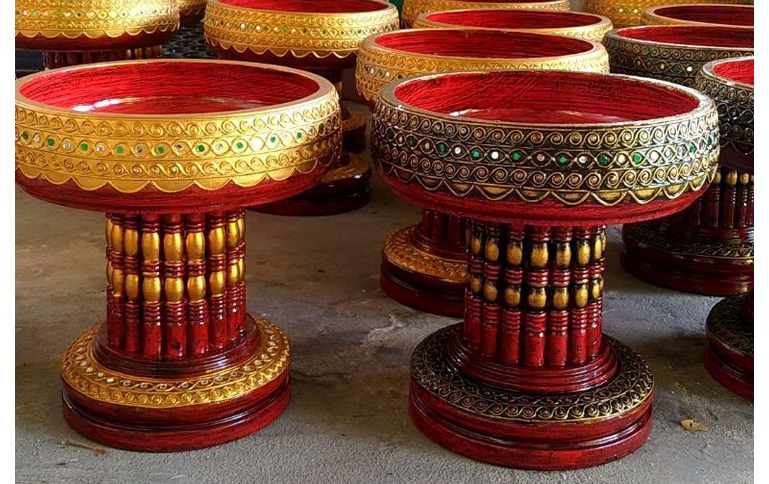
Khan toke with intricate designs
(Photo credit: Smile Handicraft)
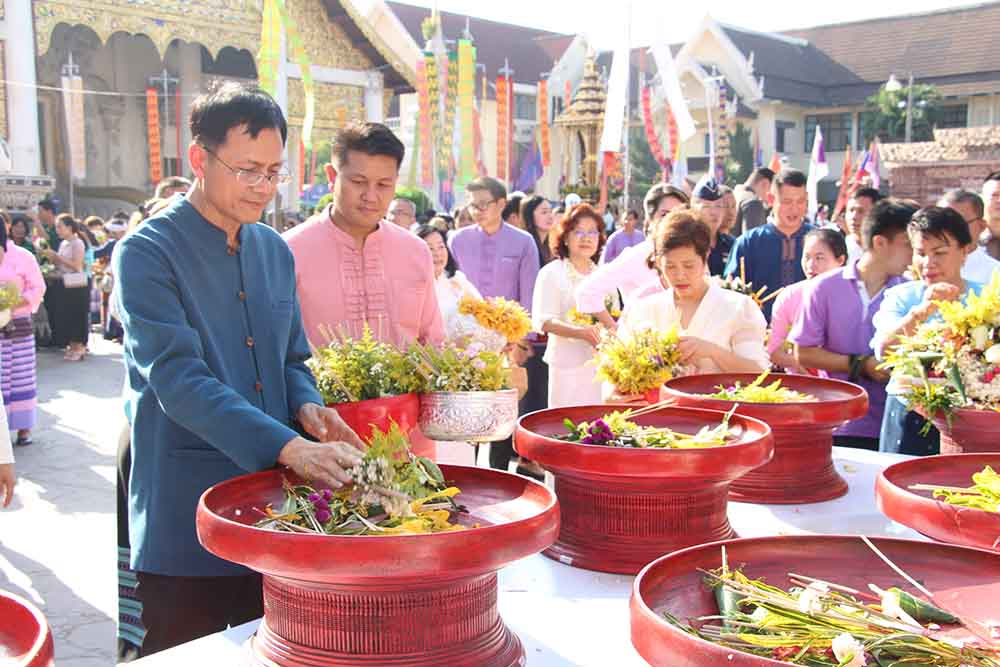
Khan toke as an offering container called khan dok
(Photo credit: iChiangmaiPR)
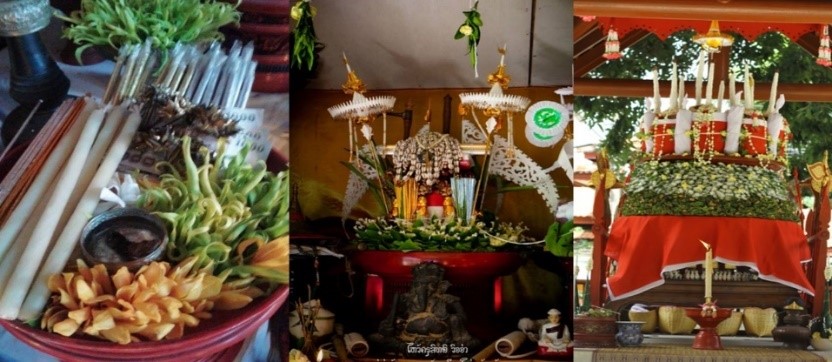
Khan toke as an offering container called khan tang
(Photo credit: Matichon Weekly)
Types and characteristics of khan toke
Khan toke can be categorized into two types according to its material: the Yuan khan toke and the Lao khan toke.
The Yuan khan toke is made of teak wood which is popularly used in Northern Thailand. The term “Yuan” refers to Northern Thai (Lanna) people. It is derived from the name of the Yonok Kingdom which is thought to be the Northern Thai’s ancient homeland. On the other hand, Lao khan toke is made of bamboo strips or rattan woven together which is commonly used in the Northeastern Thailand and Laos. Despite the two different styles and materials used, the process of making a Khan Toke involves the same techniques, including lathing, carving, and coating with natural polymers.
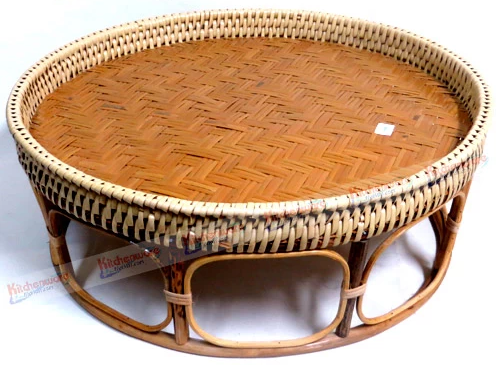
Lao khan toke made of woven rattan
(Photo credit: Kitchenware Market)
Professor Manee Payomyong, a specialist in Lanna culture, has also classified Northern Thai khan toke into 3 types.
- Khan toke luang (ขันโตกหลวง–royal khan toke): is the largest size of khan toke, with a diameter of 23-25 inches. It is normally used in palaces or aristocratic households. Additionally, it is used in temples to place large-scale offerings to monks.
- Khan toke ham (ขันโตกฮาม) or satoke tharam (สะโตกทะราม–middle-sized khan toke): is a medium-sized khan toke with a diameter approximately 17-24 This kind of khan toke is mostly used in wealthy and noble families, and in large gatherings.
- Khan toke noi (ขันโตกน้อย–Small khan toke): is the smallest size of khan toke, having a diameter of 10-15 inches. It is used for dining in small families and for placing offerings in small-scale temples.
Khan toke aesthetic style and decoration depend on the social status and economic factors of each household. High-ranking individuals generally use extravagant khan tokes. These may include those adorned with silver, gold, gilded lacquer, or lacquer with mother of pearl. Their khan tokes also feature sophisticated patterns, such as lotus flower pattern, bullet wood flower (phikun flower) pattern, and so forth.
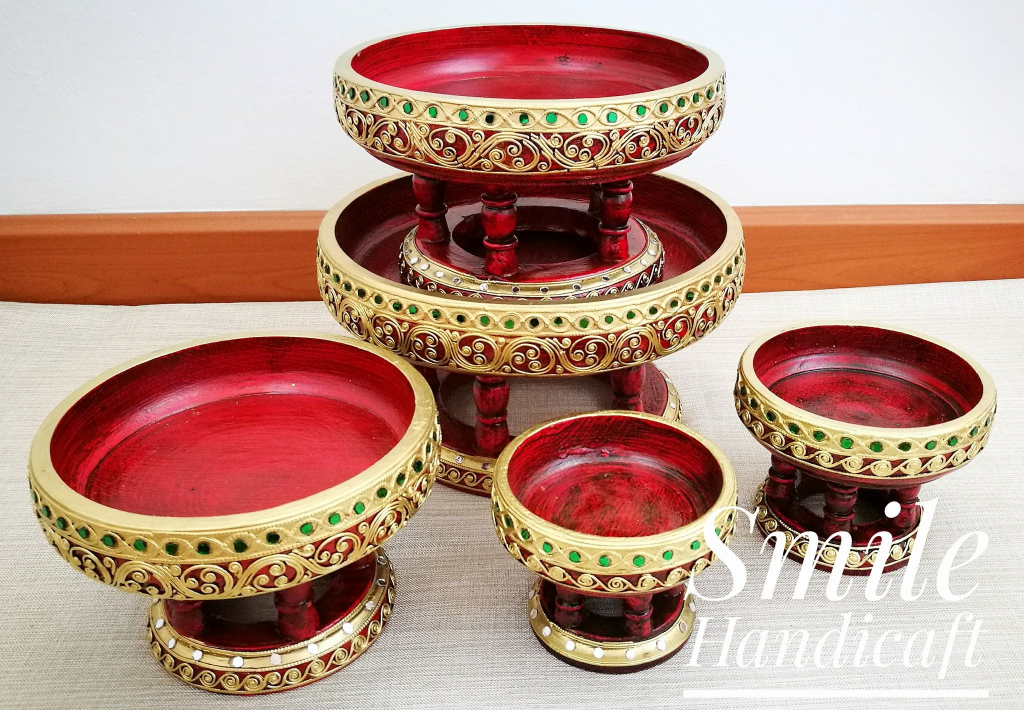
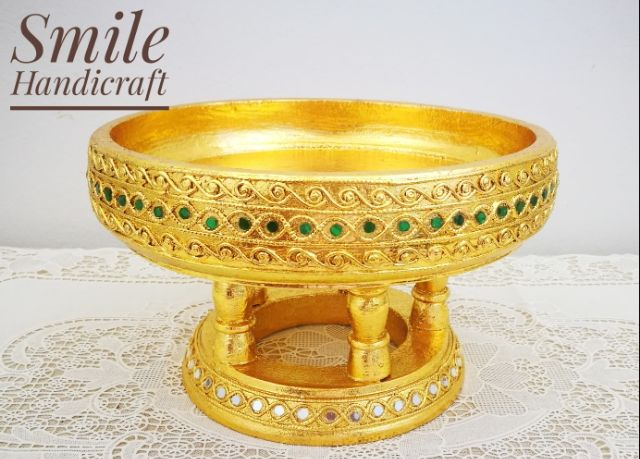

Varied sizes and styles of khan toke
(Photo credit: Smile Handicraft, SmartBizArts)
What is a khan toke dinner?
The presentation of khan toke meal has been a Northern Thai tradition since the olden days. Local hosts offer Northern Thai meal sets served on khan toke to welcome guests and to celebrate special occasions. As time went by, the presentation of khan toke meal became commercialized as an experience for tourists. This adapted “khan toke dinner” experience features a variety meal sets for diners to choose from, including vegetarian options in some places. The meal is often served in a decorated setting, accompanied by traditional performances, such as the Fon Lep (Thai Fingernail Dance), Fon Thien (Thai Candle Dance), and Fon Jerng Daab (Thai Sword Dance). The whole experience seeks to recreate how a high-ranking guest would be received in ancient times. With its increasing popularity, khan toke dinner has become a must-do experience for many tourists visiting Northern Thailand, with many venues for diners to choose from.

Khan toke dinner
(Photo credit: Focus Asia Travel)
Conclusion
Khan toke is a Northern Thai tradition that reflects the values of Thai people. The first value, respect, is exemplified through the use of khan toke as a dining table, where food is delicately presented to show respect to guests. On top of that, khan toke, as an offering container also highlights the Thai people’s deep sense of reverence towards monks and spiritual entities. The second value, compassion, can be seen through the effort to create a harmonious and memorable khan toke meal for guests. This demonstrates a genuine act of kindness from the host, who wishes to make the guest feel welcomed. The third value, openness, is represented through khan toke’s symbolic value as a welcoming gesture towards travelers from all over the world. The object is a part of an effort to create an impressive dining experience for all visitors. In addition, the practice of in-house family dining using khan toke provides an opportunity for family members from diverse age groups and backgrounds to come together, share their perspectives, and engage in meaningful discussions during the meal. By encompassing these values, khan toke is truly an embodiment of the Thai cultural heritage to be appreciated and cherished for generations.
The story of “khan toke” is an admirable part of Thai culture and heritage. We saw how this humble house-hold item can carry so much meaning as a symbol of respect, compassion, and openness. Join us in exploring more stories of Thailand and the Thai people, as we take you on a journey to discover Thainess.
Sources:
- http://bit.ly/3PGpByv
- https://bit.ly/3r8GSpQ
- https://bit.ly/46uq3Wx
- https://www.chiangmainews.co.th/page/archives/512984
- https://cooking.kapook.com/view87003.html
- https://elibrary.tceb.or.th/getattachment/c1f7e291-bfb0-425a-b0c7-1527b338dc72/6140.aspx
- https://guide.michelin.com/th/en/article/features/on-the-culinary-trail-khan-tok-dining-in-the-north
- https://idaytrip.com/khantoke-thai-lanna-traditional-food-culture/
- https://lannainfo.library.cmu.ac.th/lannafood/culture_lanna3.php
- https://www.matichonweekly.com/column/article_48313
- https://mychiangmaitour.com/chiangmai_khantoke/
- https://www.mychiangmaitravel.com/khantoke/
- https://www.youtube.com/watch?v=2cELTh_Z5w4
- https://www.youtube.com/watch?v=2zdTxsa7WuI
Author: Pathitta Promsakha Na Sakolnakorn
Editor: Tayud Mongkolrat
20 July 2023


